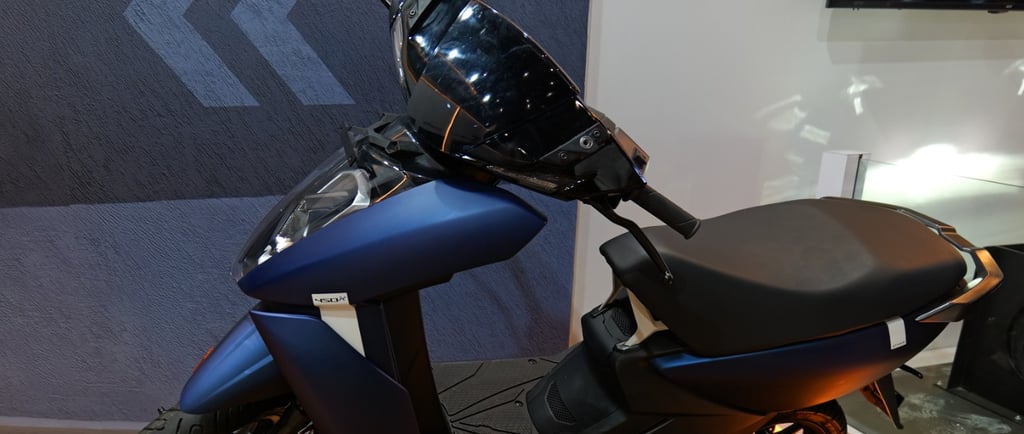Ather EV – Truly Indian or Just Assembled Here?
MD AMIR
10/3/20253 min read


Ather Energy’s journey began in 2009 at IIT Madras, where Tarun and Swapnil started working on energy-related projects. Their initial venture was a fan called Famp, designed to convert thermal energy from oil lamps into electrical power, but it failed to take off. However, their interest in the energy sector persisted.
During their final semester, Tarun became fascinated with battery swapping, convinced that electric vehicles (EVs) were the future. They initially aimed to manufacture lithium-ion batteries to refurbish aging EVs.
In 2013, Ather pivoted from battery packs to developing India’s first smart electric scooter. The existing electric scooters in the Indian market were of poor quality, often imported from China, and failed to meet performance expectations. Ather aspired to create a superior scooter that could rival petrol-powered ones in performance and design. This required designing and manufacturing the scooter entirely in India. Starting in their college robotics lab, they built their first prototype with a ₹5 lakh grant and later raised funds through pre-orders, eventually securing investment from an IIT alumnus. The journey to create a production-ready model was long and difficult, with many Indian vendors initially unable to meet their quality requirements.
The development phase was intense, spanning five years and resulting in the unveiling of the Ather S340 in 2016. However, translating a functional prototype into a production-ready vehicle was still challenging. They had to design and manufacture every component themselves, requiring a network of vendors capable of meeting their stringent quality standards. Many Indian vendors were ill-equipped to produce parts to Ather’s specifications, which delayed the progress.
Hero Motocorp’s investment of ₹205 crore in Ather was a turning point, providing financial and strategic support. With Hero’s backing, Ather set up a production facility in Bengaluru and finally launched the Ather 340 and Ather 450 in 2018. The Ather 450, in particular, lived up to its promise, outperforming even petrol scooters in acceleration. Despite their innovative product, Ather faced significant financial challenges. Although the Ather 450 was a high-performance scooter, its steep production cost of nearly ₹5 lakh, compared to a selling price of ₹1.25 lakh, led to heavy losses. To survive, Ather scaled back production and used Hero’s support to streamline operations, finally reaching positive margins by 2021.
However, by this time, the competitive landscape had changed dramatically.
While Ather was grappling with financial viability, competitors like Okinawa, TVS, Bajaj, and Ola Electric entered the market. Okinawa, by importing scooters from China, captured a significant market share, and Ola’s aggressive marketing strategies overshadowed Ather’s efforts. By 2024, Ola dominated the market with a 50% share, while Ather lagged behind.
Ather’s marketing strategy, or lack thereof, contributed to its struggles. CEO Tarun had always emphasized product development and customer service over marketing. Consequently, while competitors aggressively marketed their products, Ather’s superior quality failed to translate into sales.
Despite its setbacks, Ather managed to build a strong reputation for quality and innovation. Customer feedback highlights satisfaction with Ather’s scooters, and word of mouth has been a significant growth driver. The company had also focused on software, recognizing its potential as a future revenue stream.
Made in India: Myth or Reality?
Ather’s claim of being a “Made in India” brand is largely credible and well-substantiated. The company’s journey began with in-house design and engineering, with the development of its first smart scooter, the Ather S340, initiated from scratch in the robotics lab at IIT Madras.
One of the early challenges Ather faced was the lack of Indian vendors capable of meeting their stringent quality standards. However, instead of resorting to mass imports, Ather chose to collaborate with domestic suppliers and gradually built a reliable vendor ecosystem focused on quality manufacturing. The brand further solidified its Indian roots by establishing a full-scale production facility in Bengaluru in 2016, following a strategic investment from Hero MotoCorp.
In addition to hardware, Ather also developed its proprietary software platform, AtherStack, entirely in-house. This robust system supports over-the-air (OTA) updates, ride analytics, navigation, and diagnostics, showcasing the brand’s commitment to end-to-end innovation within India.
Showcase at Bharat Mobility Global Expo 2025
At Bharat Mobility Global Expo 2025, Ather displayed the recently launched 2025 models—the 450S, 450X (in both 2.9 kWh and 3.7 kWh variants), and the high-end 450X Apex.
These scooters come with refreshed colorways, enhanced traction control, new multi-compound MRF tyres, MagicTwist throttle tech, and updated AtherStack 6 software. The Rizta e-scooter was also on display at the Expo.
Accessories
Shop the latest products and accessories for bikes
Contact Us
© 2024. All rights reserved.
BikeGadi
Website Managed By: Ekrida Services Private Ltd
